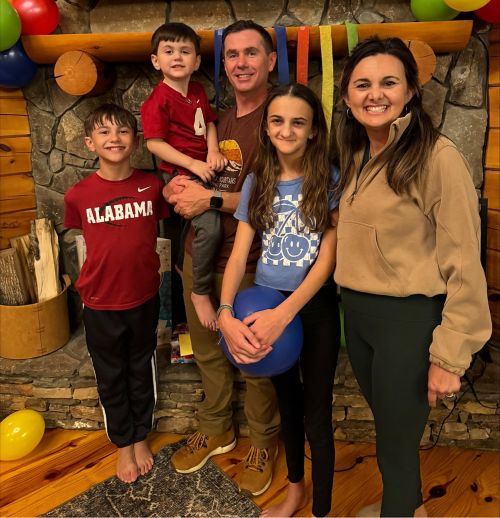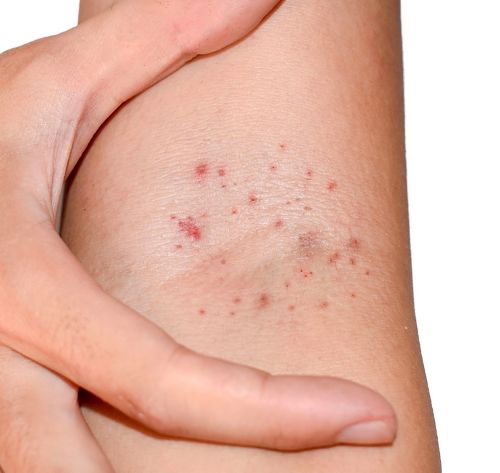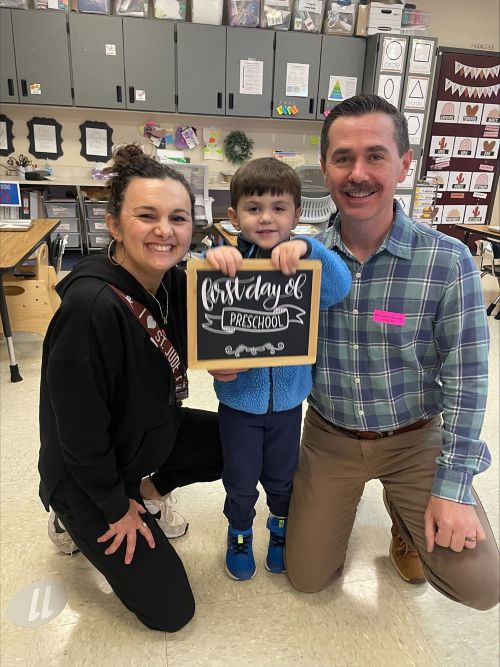Mom’s Advice for Rare Disorder: Take One Day at a Time

Meet the Ray family (Left to right: Henry, Thomas, Dustin, Ella, and Kellie.)
The Ray family’s journey with SAMD9/SAMD9L syndrome started with little red dots.
They appeared on the soft, sweet-smelling skin of newborn Ella Ray, the firstborn child of Kellie and Dustin Ray.
Kellie pointed out the curious, rash-like marks on her daughter's belly to Ella’s pediatrician at the infant’s 2-month well-baby checkup.

Petechiae can look similar to a rash. The dots show bleeding under the skin and can be a sign of health problems.
The doctor ordered a complete blood count test. The dots could be petechiae, a sign of bleeding under the skin.
The blood test showed that Ella had dangerously low numbers of red blood cells, white blood cells, and platelets, which are major parts of the blood. Ella needed blood transfusions right away.
The new parents were swept into a world of hospital stays, IVs, diagnostic tests, and waiting.
“I was a first-time parent, so I didn't know what to expect,” Kellie says. “Looking back, I think about the things I should have said and done. I didn’t know anything. The unknown was the scariest part. And that’s how it’s been for the whole journey.”
Indeed, dealing with the unknown would become a big part of their lives for the next several years.
Getting a diagnosis
At first, doctors thought Ella had leukemia. They needed a bone marrow sample to make a diagnosis. Located in the center of most bones, bone marrow is soft, sponge-like tissue that makes blood cells. The care team had trouble getting enough tissue from Ella because she was so tiny.
Tests ruled out leukemia. The care team ran more tests but could not find the cause of Ella’s low blood cell counts.
Doctors sent the family home, and Ella seemed to get better. But then Kellie found blood in Ella’s diaper.
More tests.
More waiting.
More unknown.
Several weeks later, Ella’s family had answers. When Ella was 6 months old, doctors diagnosed her with monosomy 7 myelodysplastic syndrome, a rare blood disease in which the body does not make enough healthy blood cells. Without treatment, there was a good chance the disorder could change into acute myeloid leukemia, a difficult-to-treat form of leukemia.
Time was critical. Several weeks later, the infant girl had a stem cell (bone marrow) transplant at a hospital near her family’s home in Alabama. It cured the disease.
"It is normal to feel overwhelmed. The advice I would give to any parent is to take it day by day. Looking too far into the future became overwhelming for me, so I dealt with whatever happened that day. Then I woke up the next morning ready to conquer whatever was going happen that day."
SAMD9/SAMD9L syndrome revealed
But the Ray family’s experience with the blood disorder was not over.
Their son Henry was born a few years later. The family kept a close watch on his blood cell counts. Henry did not have problems.
Their third child, Thomas, was born in 2019. The family watched his blood counts too. Everything seemed normal at first. Then, at Thomas’ 2-year-old well-child checkup, his blood cell counts were low.
His pediatrician thought a virus might be the cause. His counts stayed low. They were not low enough to cause health problems, but the doctor referred Thomas to the St. Jude Affiliate Clinic at Huntsville Hospital for Women & Children.
Blood tests showed he had the same disorder as Ella — monosomy 7 myelodysplastic syndrome. Doctors now knew that this disorder was caused by a gene mutation (mistake) called SAMD9/SAMD9L. Doctors tested the whole family to see if other members had it.
Kellie, Ella, and Thomas all had the same gene mutation. Dustin and Henry did not.
Kellie recalls her parents telling her that when she was 18 months old she had been admitted to the hospital because she had low blood cell counts. But her condition improved on its own.
SAMD9/SAMD9L syndrome sometimes goes away on its own, as it did for Kellie. For others, it may develop into myelodysplastic syndrome if untreated.
Doctors referred Thomas to the Bone Marrow Failure and Myelodysplastic Syndrome (BMF/MDS) clinic at St. Jude Children's Research Hospital. The clinic is a global expert center for SAMD9/SAMD9L disorders and has a registry for the rare disorder.
Based on their knowledge and experience with the disorder, doctors recommended a “watchful waiting” approach and monitoring Thomas’ blood cell counts. They did not want him to have a stem cell transplant if he did not need one.
“The unknowns came back,” Kellie says. “You can’t really plan very far ahead for trips or anything because you don’t know what may happen. Will it go away? Will the doctors recommend transplant?”

Thomas (center) with his parents, Kellie (left) and Dustin (right), on his first day of preschool.
A decision at last
The doctors watched Thomas’ health closely for 2 years and performed many genetic tests in the blood and bone marrow. These tests were done to see if the disease goes away on its own.
Then Thomas’ blood counts dropped low enough that he needed blood transfusions and IV doses of antibiotics to help him fight infections. He had to be hospitalized any time he had a fever because his immune system was so weak.
Like Ella, Thomas needed a stem cell transplant. Kellie and Dustin were scared because Ella had serious complications from her transplant.
“Once we decided on the transplant, it was almost a relief,” Kellie says. “We were scared because of what we went through with Ella, but it was like, ‘Let’s hurry up and get this done.’ We had waited for so long. We were ready to be on the other end.”
Today, Thomas is an active 5-year-old. He gets physical, occupational, and speech therapy to help him catch up on developmental milestones that were delayed while he had his health problems. He loves to play with cars, trains — anything with wheels. He returns to St. Jude every 6 months for follow-up.
Looking back on her family’s journey, Kellie has this advice for parents:
“It is normal to feel overwhelmed,” she says. “The advice I would give to any parent is to take it day by day. Looking too far into the future became overwhelming for me, so I dealt with whatever happened that day. Then I woke up the next morning ready to conquer whatever was going happen that day.”





